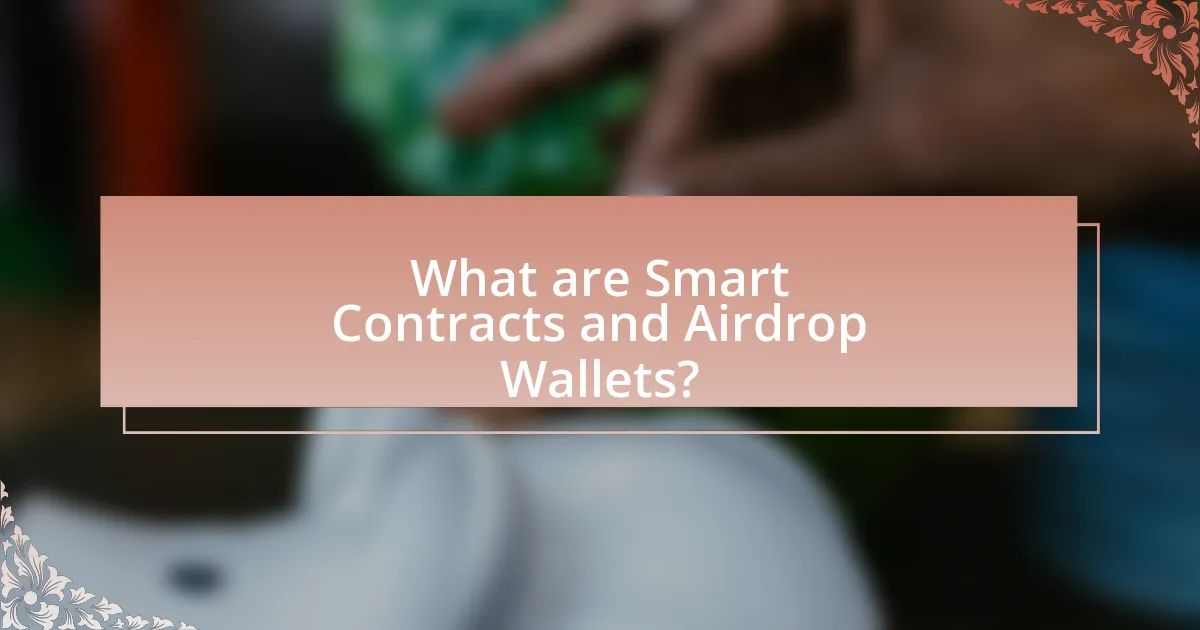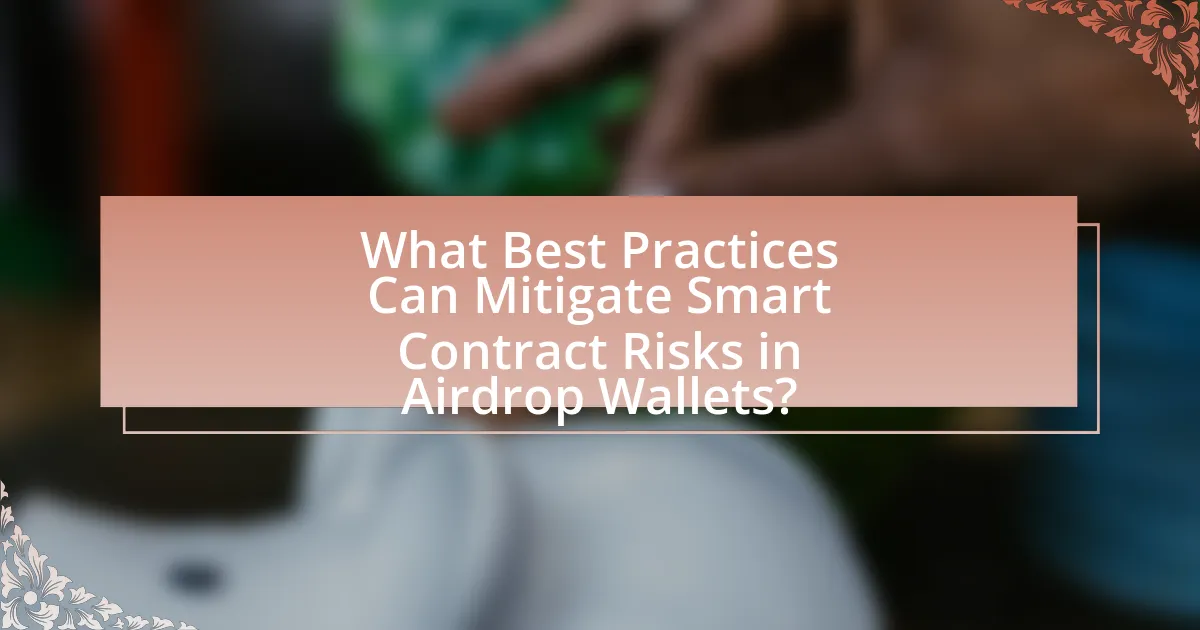Smart contracts are self-executing agreements coded on blockchain networks, providing automation, transparency, and security by eliminating intermediaries. Airdrop wallets are specialized digital wallets designed to securely receive free cryptocurrency tokens, often distributed through promotional campaigns. This article examines the risks associated with smart contracts, including coding errors and security vulnerabilities, and their implications for airdrop wallet security. It also discusses best practices for mitigating these risks, ensuring the reliability of smart contracts, and protecting users from potential scams and unauthorized access.

What are Smart Contracts and Airdrop Wallets?
Smart contracts are self-executing contracts with the terms of the agreement directly written into code, enabling automated transactions on blockchain networks. They operate on decentralized platforms like Ethereum, ensuring transparency and security by eliminating the need for intermediaries. Airdrop wallets are digital wallets specifically designed to receive cryptocurrency tokens distributed for free, often as part of promotional campaigns or to incentivize user engagement. These wallets must be secure to protect against potential vulnerabilities associated with smart contracts, as improper coding can lead to exploits that compromise both the contract and the funds within the airdrop wallet.
How do Smart Contracts function in the blockchain ecosystem?
Smart contracts function as self-executing contracts with the terms of the agreement directly written into code on the blockchain. They automatically enforce and execute contractual agreements when predefined conditions are met, eliminating the need for intermediaries. For example, on the Ethereum blockchain, smart contracts are deployed using the Ethereum Virtual Machine (EVM), which processes the contract’s code and ensures that all transactions are immutable and transparent. This functionality is supported by the decentralized nature of blockchain technology, which ensures that once a smart contract is deployed, it cannot be altered, thus providing security and trust in the execution of agreements.
What are the key features of Smart Contracts?
Smart contracts are self-executing contracts with the terms of the agreement directly written into code. Key features include automation, which eliminates the need for intermediaries, enhancing efficiency and reducing costs. They are immutable, meaning once deployed on a blockchain, the code cannot be altered, ensuring trust and security. Additionally, smart contracts are transparent, as all transactions are recorded on the blockchain, allowing for verification by all parties involved. Finally, they are decentralized, operating on a distributed network, which reduces the risk of single points of failure. These features collectively contribute to the reliability and effectiveness of smart contracts in various applications, including financial transactions and decentralized applications.
How do Smart Contracts ensure security and trust?
Smart contracts ensure security and trust through their self-executing nature and the use of blockchain technology. By automating transactions and agreements, smart contracts eliminate the need for intermediaries, reducing the risk of fraud and manipulation. The code is stored on a decentralized blockchain, making it immutable and transparent; once deployed, the contract cannot be altered, ensuring that all parties adhere to the agreed terms. Additionally, the consensus mechanism of the blockchain validates transactions, further enhancing security. According to a report by the World Economic Forum, blockchain technology can reduce transaction costs by up to 40%, demonstrating its efficiency and reliability in maintaining trust among users.
What role do Airdrop Wallets play in cryptocurrency transactions?
Airdrop wallets facilitate the distribution of cryptocurrency tokens to users, enabling them to receive free tokens as part of promotional campaigns or network upgrades. These wallets are essential for managing and storing the airdropped tokens securely, ensuring that recipients can access and utilize their assets effectively. Airdrop wallets often require users to complete specific tasks, such as following social media accounts or joining community groups, which helps to increase engagement and awareness of the cryptocurrency project. The security of airdrop wallets is crucial, as vulnerabilities can lead to unauthorized access and loss of tokens, highlighting the importance of understanding smart contract risks associated with their use.
What are the different types of Airdrop Wallets?
The different types of airdrop wallets include software wallets, hardware wallets, and paper wallets. Software wallets, such as mobile and desktop applications, allow users to easily receive and manage airdropped tokens. Hardware wallets provide enhanced security by storing private keys offline, making them less vulnerable to hacks. Paper wallets involve printing the private keys and public addresses on paper, offering a completely offline method for storing cryptocurrencies. Each type of wallet serves different user needs, balancing convenience and security in the context of airdrop participation.
How do Airdrop Wallets facilitate token distribution?
Airdrop wallets facilitate token distribution by automating the process of sending tokens to multiple recipients simultaneously. These wallets utilize smart contracts to execute predefined conditions for distribution, ensuring that tokens are allocated based on criteria such as user eligibility or participation in a specific event. For instance, airdrop wallets can distribute tokens to users who hold a certain amount of another cryptocurrency, thereby incentivizing participation and engagement within a blockchain ecosystem. This method enhances efficiency and reduces the potential for human error in the distribution process, as transactions are executed automatically and transparently on the blockchain.

What are the Risks Associated with Smart Contracts?
The risks associated with smart contracts include coding errors, security vulnerabilities, and lack of regulatory clarity. Coding errors can lead to unintended consequences, as seen in the DAO hack of 2016, where a vulnerability allowed an attacker to drain $60 million worth of Ether due to a flaw in the smart contract code. Security vulnerabilities, such as reentrancy attacks, can exploit weaknesses in contract execution, potentially resulting in significant financial losses. Additionally, the lack of regulatory clarity can expose users to legal risks, as the legal status of smart contracts remains ambiguous in many jurisdictions, complicating enforcement and compliance.
What common vulnerabilities exist in Smart Contracts?
Common vulnerabilities in smart contracts include reentrancy attacks, integer overflow and underflow, gas limit and loops, timestamp dependence, and improper access control. Reentrancy attacks occur when a contract calls another contract and allows the second contract to call back into the first contract before the initial execution is complete, potentially leading to unexpected behavior. Integer overflow and underflow happen when arithmetic operations exceed the maximum or minimum limits of data types, causing incorrect calculations. Gas limit and loops can lead to failures in execution if a contract requires more gas than is available, particularly in loops that do not have a defined exit condition. Timestamp dependence arises when contracts rely on block timestamps for critical logic, which can be manipulated by miners. Lastly, improper access control can allow unauthorized users to execute functions that should be restricted, leading to potential exploitation. These vulnerabilities have been documented in various audits and reports, highlighting the need for rigorous testing and security practices in smart contract development.
How can coding errors lead to security breaches?
Coding errors can lead to security breaches by creating vulnerabilities that malicious actors can exploit. For instance, improper input validation can allow attackers to execute arbitrary code or manipulate data, leading to unauthorized access or data theft. A notable example is the DAO hack in 2016, where a coding flaw in a smart contract allowed an attacker to siphon off $60 million worth of Ether. This incident highlights how even minor coding mistakes can have significant security implications, emphasizing the need for rigorous testing and code audits in smart contract development.
What are the implications of poorly designed Smart Contracts?
Poorly designed smart contracts can lead to significant financial losses, security vulnerabilities, and legal disputes. These contracts may contain bugs or loopholes that malicious actors can exploit, resulting in unauthorized access to funds or data breaches. For instance, the DAO hack in 2016, which exploited a vulnerability in a smart contract, resulted in the loss of $60 million worth of Ether, highlighting the real-world consequences of design flaws. Additionally, poorly designed contracts can create ambiguity in terms of execution and enforcement, leading to disputes among parties involved. This can result in costly litigation and damage to reputations, further emphasizing the importance of rigorous testing and auditing in smart contract development.
How do these risks affect Airdrop Wallet Security?
Smart contract risks significantly compromise Airdrop Wallet Security by exposing users to vulnerabilities such as hacking, phishing, and code exploits. These risks can lead to unauthorized access to funds, loss of assets, and potential breaches of personal information. For instance, a study by the Blockchain Security Company in 2021 reported that over $1.3 billion was lost due to smart contract vulnerabilities, highlighting the critical need for robust security measures in Airdrop Wallets.
What specific threats do Airdrop Wallets face from Smart Contract vulnerabilities?
Airdrop wallets face specific threats from smart contract vulnerabilities, primarily including unauthorized access, loss of funds, and exploitation of coding flaws. Unauthorized access can occur when a smart contract contains bugs that allow malicious actors to manipulate the contract’s functions, leading to unauthorized transfers of tokens. For instance, the Parity wallet hack in 2017, which exploited a vulnerability in a smart contract, resulted in the loss of over $30 million worth of Ether. Additionally, poorly designed smart contracts may expose airdrop wallets to reentrancy attacks, where an attacker repeatedly calls a function before the initial execution completes, draining funds. The DAO hack in 2016 is a notable example, where a reentrancy vulnerability led to the theft of $60 million in Ether. These vulnerabilities highlight the critical need for rigorous smart contract auditing and testing to safeguard airdrop wallets against potential threats.
How can attackers exploit weaknesses in Airdrop Wallets?
Attackers can exploit weaknesses in Airdrop Wallets primarily through vulnerabilities in smart contracts and phishing attacks. Smart contracts may contain coding flaws that allow unauthorized access or manipulation of funds, as evidenced by incidents like the DAO hack in 2016, where a vulnerability in the smart contract led to the loss of $60 million worth of Ether. Additionally, attackers often use phishing techniques to trick users into revealing their private keys or recovery phrases, which can lead to unauthorized access to their wallets. These methods highlight the critical need for robust security measures in Airdrop Wallets to mitigate such risks.

What Best Practices Can Mitigate Smart Contract Risks in Airdrop Wallets?
Implementing rigorous code audits is a best practice that can significantly mitigate smart contract risks in airdrop wallets. Code audits, conducted by reputable third-party firms, identify vulnerabilities and ensure compliance with security standards, reducing the likelihood of exploits. For instance, the 2020 DeFi hack of the bZx protocol, which resulted in a loss of $8 million, highlighted the importance of thorough audits, as the vulnerabilities were not addressed prior to deployment. Additionally, utilizing established frameworks and libraries, such as OpenZeppelin, can further enhance security by providing tested and community-reviewed code. Regular updates and monitoring of smart contracts also play a crucial role in addressing newly discovered vulnerabilities, ensuring ongoing protection against potential threats.
How can developers ensure the security of Smart Contracts?
Developers can ensure the security of smart contracts by implementing rigorous testing and auditing processes. These processes include using formal verification methods to mathematically prove the correctness of the contract’s logic, which helps identify vulnerabilities before deployment. Additionally, employing automated tools for static and dynamic analysis can uncover potential security flaws. According to a study by the Ethereum Foundation, smart contracts that underwent thorough audits experienced a 50% reduction in vulnerabilities compared to those that did not. Furthermore, developers should follow best practices such as adhering to established coding standards and utilizing well-reviewed libraries to minimize risks.
What testing methods are effective for Smart Contract security?
Effective testing methods for Smart Contract security include formal verification, static analysis, dynamic analysis, and fuzz testing. Formal verification mathematically proves the correctness of the contract’s logic, ensuring it behaves as intended under all conditions. Static analysis tools, such as Mythril and Slither, analyze the code without executing it, identifying vulnerabilities like reentrancy and integer overflow. Dynamic analysis involves executing the contract in a controlled environment to observe its behavior and identify runtime issues. Fuzz testing inputs random data into the contract to uncover unexpected behaviors or vulnerabilities. These methods collectively enhance the security of Smart Contracts by systematically identifying and mitigating risks.
How can audits improve Smart Contract reliability?
Audits can improve Smart Contract reliability by systematically identifying vulnerabilities and ensuring compliance with best practices. Through comprehensive code reviews and testing, audits help detect logical errors, security flaws, and inefficiencies that could lead to exploitation or failure. For instance, a study by ConsenSys Diligence found that 70% of smart contracts audited revealed critical vulnerabilities, highlighting the importance of audits in enhancing security. By addressing these issues before deployment, audits significantly reduce the risk of financial loss and enhance user trust in the smart contract’s functionality.
What strategies can users employ to protect their Airdrop Wallets?
Users can protect their Airdrop Wallets by implementing several key strategies. First, they should enable two-factor authentication (2FA) on their wallets, which adds an extra layer of security by requiring a second form of verification beyond just a password. Additionally, users should regularly update their wallet software to ensure they have the latest security patches, as vulnerabilities are often addressed in updates.
Moreover, users must avoid sharing their private keys or seed phrases, as these are critical for accessing their wallets and can lead to unauthorized access if disclosed. Utilizing hardware wallets for storing cryptocurrencies can also enhance security, as these devices keep private keys offline and away from potential online threats.
Lastly, users should be cautious of phishing attempts and only interact with trusted sources when participating in airdrops, as many scams target unsuspecting users. According to a report by the Blockchain Security Alliance, over 50% of cryptocurrency thefts in 2022 were due to phishing attacks, highlighting the importance of vigilance in protecting digital assets.
What precautions should users take before participating in an airdrop?
Users should verify the legitimacy of the airdrop before participating. This includes researching the project’s background, checking for official announcements on reputable platforms, and ensuring the project has a credible team and community support. According to a report by the Blockchain Security Alliance, over 60% of airdrops are associated with scams or fraudulent activities, highlighting the importance of due diligence. Additionally, users should never share private keys or sensitive information, as legitimate airdrops will not require this data.
How can users recognize and avoid potential scams in Airdrop Wallets?
Users can recognize and avoid potential scams in Airdrop Wallets by verifying the legitimacy of the airdrop source and being cautious of unsolicited offers. Scammers often impersonate legitimate projects, so users should only participate in airdrops from official channels, such as the project’s website or verified social media accounts. Additionally, users should never share their private keys or sensitive information, as legitimate airdrops will never ask for this data. According to a report by the Blockchain Security Alliance, over 60% of airdrop scams involve phishing attempts, highlighting the importance of vigilance and thorough research before engaging with any airdrop.


